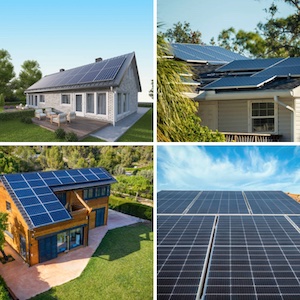Your Utility Bill After Solar
Understanding Your Utility Bill After Solar
Installing a residential solar system reshapes your utility bill, offering savings and greater control over energy costs. With Eskom’s tariffs and regional differences in solar policies, understanding how your consumption patterns affect savings is key. This article explores how your bill changes post-solar, comparing grid-tied and off-grid systems for households with different daytime and nighttime usage. We focus on two scenarios: consumers using 60% of power during the day and 40% at night, versus those using 40% during the day and 60% at night, particularly in regions like the Western Cape and Gauteng where solar adoption thrives.
How Solar Impacts Your Eskom Bill
Solar panels generate electricity during daylight, offsetting what you’d draw from Eskom, where tariffs range from R2.00 to R4.50 per kWh. For a household consuming 900 kWh monthly, the bill could hit R3,500 without solar, driven by inclining block tariffs for usage above 600 kWh. Fixed charges (R200–R900 monthly) also apply, regardless of consumption. Your savings depend on system type, consumption timing, and regional policies.
Key factors affecting your bill include:
- System Size: A 5 kW system produces 600–750 kWh monthly, covering much of a typical household’s needs.
- Fixed Fees: These persist for grid-tied systems, reducing overall savings.
- Western Cape Advantage: Here, you can feed excess power back to the grid, earning credits at R0.79 per kWh plus incentives, unlike other provinces.
Daytime-heavy users (60% day, 40% night) maximize solar output, as panels directly power appliances like geysers or washing machines. Nighttime-heavy users (40% day, 60% night) rely more on the grid or batteries, impacting savings, especially without feed-in tariffs outside the Western Cape.
Grid-Tied vs. Off-Grid Systems
Grid-tied systems connect to Eskom or municipal grids, while off-grid systems rely on batteries for independence. Each suits different needs, with costs and savings varying by usage patterns:
Grid-Tied Systems:
- Cost: R100,000–R200,000 for a 5 kW system with a hybrid inverter, common in the Western Cape and Gauteng due to higher incomes.
- Pros: Affordable, grid backup, and feed-in credits in the Western Cape.
- Cons: Fixed charges and load shedding risks unless batteries are added.
Off-Grid Systems:
- Cost: R200,000–R350,000, including 10 kWh battery storage, mostly seen in Gauteng’s affluent areas.
- Pros: No utility bills, immune to outages or tariff hikes.
- Cons: High upfront and maintenance costs, less practical for most.
For a 900 kWh household, a 5 kW grid-tied system might generate 650 kWh monthly. Daytime-heavy users cover more of their 540 kWh daytime needs (60%) directly, while nighttime-heavy users cover less of their 360 kWh daytime usage (40%), leaning on the grid for 540 kWh at night. Off-grid systems eliminate bills but require batteries to store daytime power for nighttime use, inflating costs.
Comparing Savings by Usage Patterns
Savings vary significantly based on when you use electricity. The table below estimates monthly bills and savings for a 900 kWh household with a 5 kW system, assuming Eskom tariffs average R3.50 per kWh and fixed charges of R500 monthly. Western Cape grid-tied systems include feed-in credits for 100 kWh excess at R0.79 per kWh. Off-grid systems assume no utility bill but factor in R2,000 monthly financing costs for a R300,000 system over 15 years.
| System Type | Usage Pattern | Eskom Usage (kWh) | Bill (R) | Savings (R) |
| Grid-Tied (WC) | 60% Day, 40% Night | 250 (360 night – 110 credits) | R1,296 (250 × R3.50 + R500 – R79) | R2,204 |
| Grid-Tied (WC) | 40% Day, 60% Night | 430 (540 night – 110 credits) | R1,926 (430 × R3.50 + R500 – R79) | R1,574 |
| Grid-Tied (Other) | 60% Day, 40% Night | 360 (night only) | R1,760 (360 × R3.50 + R500) | R1,740 |
| Grid-Tied (Other) | 40% Day, 60% Night | 540 (night only) | R2,390 (540 × R3.50 + R500) | R1,110 |
| Off-Grid | 60% Day, 40% Night | 0 | R2,000 (financing) | R1,500 |
| Off-Grid | 40% Day, 60% Night | 0 | R2,000 (financing) | R1,500 |
Analysis: Daytime-heavy users save more with grid-tied systems, especially in the Western Cape (R2,204 vs. R1,574). Nighttime-heavy users see smaller savings (R1,110–R1,574 elsewhere), as grid reliance grows. Off-grid savings are consistent but modest due to high financing costs, making them less viable unless outages are frequent. Western Cape’s feed-in credits boost grid-tied savings, while Gauteng’s high incomes support both system types, though without credits.
Regional and Practical Considerations
The Western Cape’s feed-in program makes grid-tied systems attractive, with daytime-heavy users potentially cutting a R3,500 bill to R1,300. Nighttime-heavy users save less but still benefit from credits. Gauteng households, with high incomes, adopt grid-tied systems for savings (R1,100–R1,800) or off-grid for reliability, though costs limit the latter. Elsewhere, lower incomes restrict adoption to basic grid-tied setups, saving R1,000–R1,700 without credits.
To maximize savings:
- Adjust Usage: Shift appliances to daytime for grid-tied systems.
- Monitor Bills: Verify fixed charges and credits, especially in the Western Cape.
- System Sizing: Oversize grid-tied systems in the Western Cape for more credits; ensure off-grid batteries meet nighttime needs.
For daytime-heavy users, grid-tied systems shine, particularly in the Western Cape. Nighttime-heavy users may need batteries with grid-tied setups to boost savings, especially outside the Western Cape. Off-grid systems suit those prioritizing independence, but high costs make them niche, mainly in Gauteng. By aligning your system and habits, you can optimize your bill, whether chasing credits or cutting grid ties entirely.
Where Are You In Your Solar Journey
Researching

Ready For Quotes

Already Installed

Contact Us
Contact
+27 (0) 71 087 6723
info@solarcentral.co.za
Address
210 Amarand Avenue, Waterkloof Glen
Pretoria, South Africa
Schedule
24 Hours / 7 Days Open
Office time: 10 AM - 5:30 PM
Platform
get in touch
Ready to Get Started
Please fill out this form and we will get in touch with you shortly.
